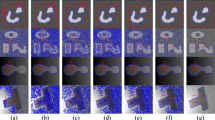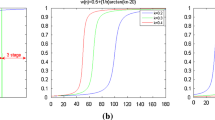Abstract
In this paper, a novel active contour model based on hybrid image fitting energy which utilizes both global and local image information is proposed. Two fitting images are constructed to approximate the original image and the square of the original image. Both global and local image information are incorporated into these two fitting images. Based on these two fitting images, a hybrid image fitting energy, which is then minimized in a variational level set framework to guide the evolving contours to the desired boundaries. The proposed approach is validated by experiments on both synthetic and real images. The experiments demonstrate that the proposed model is more efficient and robust for segmenting different kinds of images compared with several typical active contour models.








Similar content being viewed by others
Notes
The matlab source code of the C–V, the RSF, the LIF and the LGIF algorithms can be found from http://www.engr.uconn.edu/~cmli/, http://www.kaihuazhang.net/ and https://www.unc.edu/~liwa/.
References
Kass M, Witkin A, Terzopoulos D (1991) Snake: active contours model. Int J Comput Vis 1(4):1167–1186
Caselles V, Kimmel R, Sapiro G (1998) Geodesic active contours. Int J Comput Vis 22(1):61–79
Xu C, Prince JL (1998) Snakes, shapes, and gradient vector flow. IEEE Trans Image Process 7(3):359–369
Kichenassamy S, Kumar A, Olver P, et al (1995) Gradient flows and geometric active contour models. In: Proceedings of international conference on computer vision, pp 810–815
Chan T, Vese L (2001) Active contours without edges. IEEE Trans Image Process 10(2):266–277
Mumford D, Shah J (1989) Optimal approximations of piecewise smooth functions and associated variational problems. Commun Pure Appl Math 42:577–685
Osher S, Sethian JA (1998) Fronts propagating with curvature-dependent speed: algorithms based on Hamilton–Jacobi formulations. J Comput Phys 79(1):12–49
Li C, Kao C, Gore J, Ding Z (2008) Minimization of region-scalable fitting energy for image segmentation. IEEE Trans Image Process 17:1940–1949
Lankton S, Tannenbaum A (2008) Localizing region based active contour. IEEE Trans Image Process 17(11):2029–2039
Zhang K, Song H, Zhang L (2010) Active contours driven by local image fitting energy. Pattern Recognit 43(4):1199–1206
Li C, Kao C, Gore J, Ding Z (2007) Implicit active contours driven by local binary fitting energy. In: Proceedings of IEEE conference on computer vision and pattern recognition (CVPR). IEEE Computer Society, Washington, DC, pp 1–7
Wang L, Chang Y, Wang H et al (2017) An active contour model based on local fitted images for image segmentation. Inf Sci 418:61–73
Li Y, Cao Q, Yu Q et al (2018) Fast and robust active contours model for image segmentation. Neural Process Lett 1:1–22
Wang L, Li C, Sun Q et al (2009) Active contours driven by local and global intensity fitting energy with application to brain MR image segmentation. Comput Med Imaging Graph 33(7):520–531
Xie X, Wang C et al (2013) Active contours model exploiting hybrid image information: an improved formulation and level set method. J Comput Inf Syst 9(20):8371–8379
Ge Q, Li C, Shao W et al (2015) A hybrid active contour model with structured feature for image segmentation. Signal Process 108:147–158
Dai L, Ding J, Yang J (2015) Inhomogeneity-embedded active contour for natural image segmentation. Pattern Recognit 48(8):2513–2529
Kim W, Kim C (2013) Active contours driven by the salient edge energy model. IEEE Trans Image Process 22(4):1667–1673
Piovano J, Rousson M, Papadopoulo T (2007) Efficient segmentation of piecewise smooth images. In: SSVM07, Ischia, pp 709–720
Zhang Z, Xu Y, Shao L et al (2017) Discriminative block-diagonal representation learning for image recognition. IEEE Trans Neural Netw Learn Syst 29(7):3111–3125
Li X, Li C, Fedorov A et al (2016) Segmentation of prostate from ultrasound images using level sets on active band and intensity variation across edges. Med Phys 43:3090–3103
Zhang Z, Liu L, Shen F, Shen HT, Shao L (2018) Binary multi-view clustering. IEEE Trans Pattern Anal Mach Intell 1:83
Zhang Z, Shao L, Xu Y, Liu L, Yang J (2017) Marginal representation learning with graph structure self-adaptation. IEEE Trans Neural Netw Learn Syst 23:1
Ma Q, Peng J, Kong D (2017) Image segmentation via mean curvature regularized Mumford–Shah model and thresholding. Neural Process Lett 3:1–15
Gao J, Dai X, Zhu C et al (2017) Supervoxel segmentation and bias correction of MR image with intensity inhomogeneity. Neural Process Lett 8:1–14
Zhang Z, Li F, Zhao M et al (2017) Robust neighborhood preserving projection by nuclear/L2,1-norm regularization for image feature extraction. IEEE Trans Image Process 26(4):1607–1622
Ye Q, Fu L, Zhang Z et al (2018) Lp-and Ls-norm distance based robust linear discriminant analysis. Neural Netw 105:393–404
Zhang Y, Zhang Z, Qin J et al (2018) Semi-supervised local multi-manifold Isomap by linear embedding for feature extraction. Pattern Recognit 76:662–678
Kullback S, Leibler RA (1951) On information and sufficiency. Ann Math Stat 22(1):79–86
Liu T, Sun J, Zheng N et al (2007) Learning to detect a salient object. In: Proceedings of IEEE international conference on computer vision pattern recognition, pp 1–8
Dice LR (1945) Measures of the amount of ecologic association between species. Ecology 26(3):297–302
Cheng MM, et al (2011) Global contrast based salient region detection. In: Proceedings of the IEEE conference on computer vision and pattern recognition, pp 409–416
Krizhevsky A, Sutskever I, Hinton GE (2012) Imagenet classification with deep convolutional neural networks. In: NIPS, pp 1097–1105
Szegedy C, Liu W, Jia Y, Sermanet P, Reed C, Anguelov D, Erhan D, Vanhoucke V, Rabinovich A (2015) Going deeper with convolutions. In: IEEE conference on computer vision and pattern recognition, Boston, pp 1–9
Long J, Shelhamer E, Darrell T (2015) Fully convolutional networks for semantic segmentation. In: Proceedings of the IEEE conference on computer vision and pattern recognition, pp 3431–3440
Ronneberger O, Fischer P, Brox T (2015) U-net: convolutional networks for biomedical image segmentation. In: International conference on medical image computing and computer-assisted intervention. Springer, Cham, pp 234–241
He K, Zhang X, Ren S, Sun J (2016) Deep residual learning for image recognition. In: Proceedings of the IEEE conference on computer vision and pattern recognition, pp 770–778
Acknowledgements
The author (Hairong Liu) was supported by Natural Science Foundation of Jiangsu Province (BK20140965) and Natural Science Foundation of the Jiangsu Higher Education Institutions of China (14KJB110010). The author (Yu Xing) was supported by the Natural Science Foundation for Youths of Jiangsu Province (BK20171072), the Natural Science Foundation of the Higher Education Institutions of Jiangsu Province (17KJB110007) and the Open Project of Jiangsu Key Laboratory of Financial Engineering (NSK2015-15).
Author information
Authors and Affiliations
Corresponding author
Additional information
Publisher's Note
Springer Nature remains neutral with regard to jurisdictional claims in published maps and institutional affiliations.
Rights and permissions
About this article
Cite this article
Li, X., Liu, H. & Xing, Y. A Hybride Active Contour Model Driven by Global and Local Image Information. Neural Process Lett 50, 989–1003 (2019). https://doi.org/10.1007/s11063-019-10004-0
Published:
Issue Date:
DOI: https://doi.org/10.1007/s11063-019-10004-0




